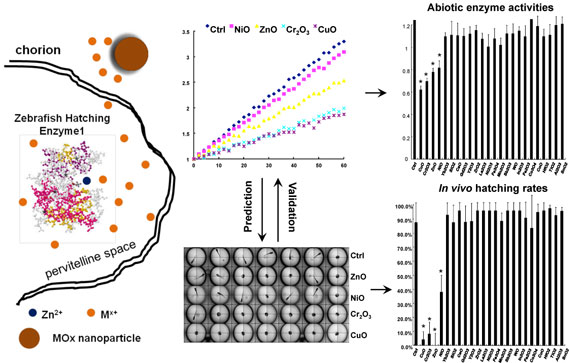| Posted: Dec 20, 2012 | |
Sustainability of nanotechnology growth requires high-throughput screening techniques |
|
| (Nanowerk Spotlight) As nanotechnologies are beginning to empower our lives in so many ways, understanding the environmental health and safety (EHS) aspect of nanotechnology has become a crucial issue. The lack of information on the impact of engineered nanomaterials on organisms and the environment motivates researchers all over the world to strive for a better understanding of the implications of nanotechnology applications. | |
| "To assure a responsible and sustainable growth of nanotechnology, the EHS aspect of engineered nanomaterials and nano related products need to be addressed at a rate commensurate with the expansion of nanotechnology," Sijie Lin, a postdoctoral researcher at the University of California's Center for Environmental Implications of Nanotechnology (CEIN), tells Nanowerk. "Zebrafish have been demonstrated as a correlative in vivo vertebrate model for such task." | |
| Zebrafish, due to its fast developmental biology and transparent body structure, is commonly used as a model system for environmental studies. Lin has first-authored a just published review in Small ("Zebrafish: An In Vivo Model for Nano EHS Studies") on the current advances of using zebrafish for nano EHS studies (see for instance our previous Nanowerk Spotlight: "Problematic new findings regarding toxicity of silver nanoparticles"). | |
| In a separately published study, also in Small ("Zebrafish High-Thoughput Screening to Study the Impact of Dissolvable Metal Oxide Nanoparticles on the Hatching Enzyme, ZHE1"), Lin, together with collaborators from various UCLA departments and the University of Bremen in Germany, provided a mechanistic understanding on how nanomaterials affect zebrafish embryos development and specifically answers the question on what causes the embryos to fail hatching at due time. | |
 |
|
| Left: schematic diagram explaining the mechanism of hatching interference due to metal ion shedding from metal oxide nanoparticles; Right: abiotic assay and in vivo screening analyzing 24 metal oxide nanoparticles. (Reprinted with permission from Wiley VCH Verlag) | |
| "One of the exciting findings of this work is that we successfully demonstrated the mechanism of metal oxide nanoparticles' toxicity to zebrafish embryos at the molecular level," says Lin. | |
| As the team hypothesized previously (see Nanowerk Spotlight: "High content screening of zebrafish greatly speeds up nanoparticle hazard assessment"), the hatching interference exerted by dissolving metal oxide nanoparticles could be due to the metal ion shedding compromising the enzymatic activity of embryo hatching enzymes." | |
| In their new study, Lin and his colleagues set out to generate active recombinant zebrafish hatching enzyme (ZHE1) and implemented an abiotic assay that allowed them to assess the enzyme activity under metal oxide nanoparticles exposure directly. | |
| Such abiotic assays could offer a quick screening tool for hazard ranking of nanomaterials. Besides nanomaterials, these assays could also be used for testing environment water samples collected from spill 'hotspots' for example. | |
| "We identified four (CuO, ZnO, Cr2O3 and NiO) out of 24 commonly used metal oxide nanoparticles that decreased the hatching enzyme activity and further conducted embryo screening of all 24 metal oxide nanoparticles to verify whether or not the decreased enzyme activity correlates with hatching interference in vivo," says Lin. | |
| The study shows, that the same four metal oxide nanoparticles consistently exerted hatching interference while others had no effect. | |
| Lin notes that such excellent correlation between the abiotic assay and in vivo screening validated the team's hypothesis on the mechanism of metal oxide nanoparticles toxicity in zebrafish embryos. | |
| He points out that another significant outcome of this work is the establishment of a high-throughput screening (HTS) platform that equips researchers to perform toxicity screening of 24 metal oxide nanoparticles concurrently. | |
| This HTS platform consists of a robotic pick-and-plate system, a high content imaging system, and a custom-built image analysis software for phenotyping of zebrafish embryos ("Automated Phenotype Recognition for Zebrafish Embryo Based In Vivo High Throughput Toxicity Screening of Engineered Nano-Materials"). | |
| Another interesting aspect that the researchers learned from this study is that the mechanism on hatching interference exerted by metal oxide nanoparticles might apply to other aquatic species, such as Japanese medaka. | |
| "We found the same metal oxide nanoparticles that exerted hatching interference in zebrafish embryos also interfere with medaka embryo hatching," says Lin. "Since the hatching enzymes of most fishes are evolutionary conserved, they share a lot of structural and functional similarities and the enzyme activity could be affected by nanomaterials under the same mechanism." | |
| According to the team, the HTS platform that has been demonstrated in this study could easily be adapted to study other nanomaterials of interest. The capability of HTS would also allow researchers to analyze multiple samples at different concentrations, time points, as well as varying experimental parameters – all in one setup. The standardization of the whole screening process by this HTS platform also minimizes human intervention and errors during the experiment. | |
 By
Michael
Berger
– Michael is author of three books by the Royal Society of Chemistry:
Nano-Society: Pushing the Boundaries of Technology,
Nanotechnology: The Future is Tiny, and
Nanoengineering: The Skills and Tools Making Technology Invisible
Copyright ©
Nanowerk LLC
By
Michael
Berger
– Michael is author of three books by the Royal Society of Chemistry:
Nano-Society: Pushing the Boundaries of Technology,
Nanotechnology: The Future is Tiny, and
Nanoengineering: The Skills and Tools Making Technology Invisible
Copyright ©
Nanowerk LLC
|
|
|
Become a Spotlight guest author! Join our large and growing group of guest contributors. Have you just published a scientific paper or have other exciting developments to share with the nanotechnology community? Here is how to publish on nanowerk.com. |
|
